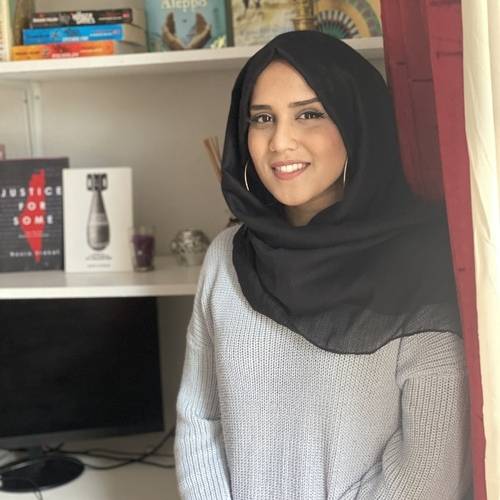Once upon a time, a Palestinian was arrested and imprisoned for simply doing his job; drawing cartoons.
Mohammad Sabaaneh, a political cartoonist, endured two weeks of his detention in solitary confinement before being held in an Israeli prison for five months. He says the Israeli government cracks down on Palestinians who use art to oppose occupation.
Like most artists and cartoonists did, Mohammad used to display Palestinian prisoners as heroes; however, once inside, he experienced a different side to the romanticised image of Palestinian prisoners.
“During my life inside the Israeli prison I found that I’m not a hero,” he said. “I’m just a normal person that wants to go back to my family and friends and that’s exactly why, as soon as I was released, I decided I will no longer depict Palestinians as heroes in my art works.”
Mohammad was born in Kuwait in 1979 and has been working as a cartoonist since 2002. His work has been published in many newspapers, including Al-Hayat Al-Jadida, the Palestinian Authority’s daily newspaper.
![Palestinian prisoners escape from high-security prison - Cartoon [Sabaaneh/Middle East Monitor]](https://i0.wp.com/www.middleeastmonitor.com/wp-content/uploads/2021/09/IMG_3463.jpg?resize=933%2C579&ssl=1)
Palestinian prisoners escape from high-security prison – Cartoon [Sabaaneh/Middle East Monitor]
“To compose my book, I used interviews I carried out with the Palestinians imprisoned with me, as well as people living in Gaza, the West Bank and Jerusalem to show how we all are stuck in a type of prison,” said Muhammad. “Those who are not behind bars are trapped within walls with no chance of getting out.”
“Even Diaspora Palestinians feel like they are stuck because most of these people around the world have this nostalgia to travel back to Palestine, return to their homelands but can’t.”
Under a debilitating siege for more than a decade, Gaza has been rightfully declared the biggest open-air prison in the world. Meanwhile, the West Bank suffers under a different kind of siege, where every Palestinian who resides there and holds official Palestinian identification papers is a prisoner in their own home.
Movement and life in Palestine, explained Muhammad, is heavily hindered by Israel’s surveillance system to enforce the settler- colonial regime.
“Just ten minutes from my home, you can find an illegal Israeli settlement, and same with my office at the university, just ten minutes away there are checkpoints. We live inside a big prison,” he said.
“My book is structured as a hybrid graphic novel, because it’s not fictional and it’s not non-fictional. I’ve mixed the two and even though the main narrator in the story is fictional, what it’s saying is all very true.”

Palestine in Black and White by Mohammad Sabaaneh
Sabaaneh’s drawings in this collection are led by a bird that makes a deal with him as it is perched on his cell window: “You bring the pencil, and I will bring the stories.”
The bird informs him of inter-generational trauma from the ongoing Israeli settler-colonialism, which Sabaaneh brings to life with striking linocut artwork, helping us to see Palestinians not as political symbols, but as people.
Black and white dominate each page, including a bold illustration of his distraught niece born while her father is imprisoned. Readers drown deeper into the darkness with each turning page as they learn the father must earn her trust when he’s released – only to be arrested again.
The short accounts grip and scar the heart, much like the powerful linocut art technique he used to compose his book. Linocut is a negative printing process made by using sharp tools to engrave a piece of linoleum, and then inking it, and pressing it into paper.
“When I was in the interrogation centre, I found a lot of Palestinian prisoners names carved into the walls of the Israeli cells but I couldn’t carve mine. It was very hard. So I decided I needed to use this particular art technique, invented in China, to carve the stories of the Palestinian prisoners.
“And this kind of technique only works with two colours. The colour that best describes life in prison, in Palestine, is black. Living under this settler colonialism regime, they do anything to dehumanise you to yourself and to the world and that is what I want to undo in my art and book. I re-humanise my people, who only want to live like other ordinary people around the world.”
Throughout history, political cartoons have shown themselves to be an extremely powerful media for satirising and criticising regimes and social customs.
Israel’s massive concrete walls and ghastly faced Israeli soldiers are a frequent feature in Sabaaneh’s work. In one part of his book, a soldier is handcuffed to Muhammad’s speech bubble and while he is charged in court in front of his wife, he wrote: “When your captor is the judge, even a glance at your loved one is noted.”
It is messages like these that give Sabaaneh’s work its edge and power.
“There is no grey area between this settler colonialism regime and freedom for Palestine. There’s no compromise between the occupier and the people under occupation here. Like the colours of my book, it’s a black and white situation.”
“For Palestinians to feel like humans again, they need to be recognised for their ordinary human needs and wants. Like the six prisoners who escaped from one of Israel’s most secure jails, they just wanted to hug their small kids, meet their mum and resume their normal life. They did an impossible thing to do normal things – that’s exactly what my artworks represent about all Palestinians. We’re not heroes, we’re humans.”











